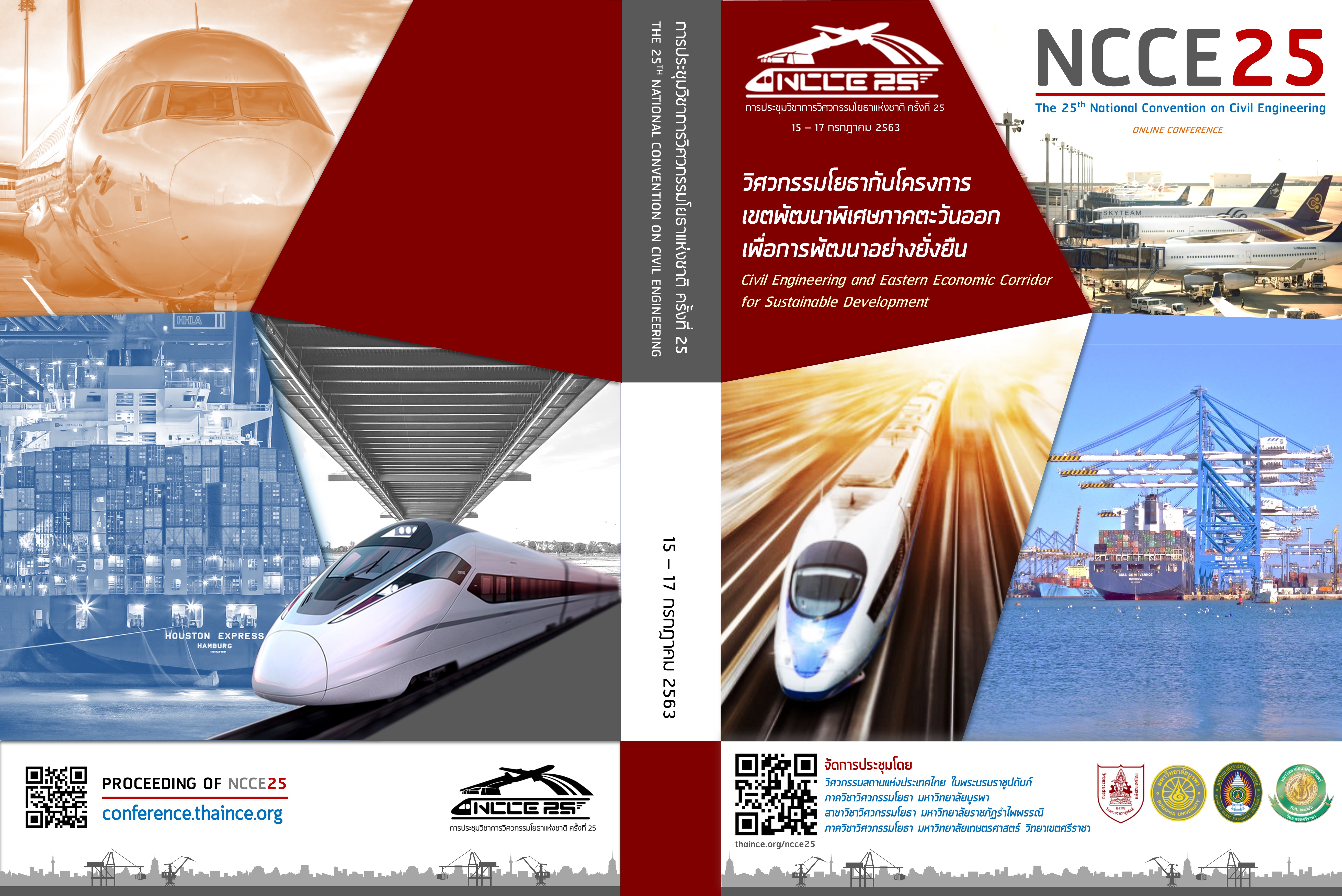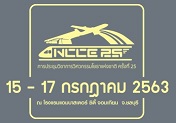Improvement of sand with bottom ash and cement as back fill materials and pavement
Keywords:
Bottom ash, Unconfined compressive strength, Resilient modulus, Poisson' Ratio, SEM, XRDAbstract
Bottom ash is a waste generated from coal burning to used as power for electricity generation causing problems of waste area disposal and pollution to the environment. This research is for realizing the benefits by proposing to improve the quality of sandy soils by using bottom ash and cement as a backfill materials and pavement materials. Experiments consisted of unconfined compressive strength (UCS), California bearing ratio (CBR), resilient modulus (Mr), and non-destructive testing using vibration waves free-free resonance test (FRR) can used to assess the strength of sandy soil, improve the quality and can used to determine the properties of seismic modulus and Poisson's ratio. The test results show that the P-wave and S-wave velocity, including the seismic modulus, are consistent with the compressive strength test results. Results show that 30% bottom ash content replacement sandy soil provided maximum strength, resilient modulus and California bearing ratio. Sandy soil, improved by bottom ash and cement, was classified as “Soil cement base” according to standard, DH-S. 204/2556, Department of highway, Thailand
Downloads
References
Abu-Farsakh, M., Dhakal, S., Chen, Q.(2015). “Laboratory characterization of cementitiously treated/stabilized very weak subgrade soil under cylic loading”Soils. Found., 55(3): 504-516.
AI-Aghbari, M. Y.,Dutta, R.K., Bundel D.(2005).“Suitability of desert sand cement mixes for base courses in Highway Pavement”, The Electronic Journal of geotechnical engineering, Vol.10.
ASTM C 597-97 Standard test method for Pulse Velocity though concrete.
ASTM D 2166-91 (1991). Standard test method for Unconfined Compressive Strength of cohesive soils, Annual book of ASTM Standards.
ASTM G 155-04a Standard practice for operating Xenon Arc Light Apparatus for
Barisic, I., Dimter, S., Rukavina, T. (2016). “Characterization of cement stabilized pavement layers with ultrasound testing”. Tehnicki vjesnik, Vol.23. pp.447-453.
Cadersa, A. S., Seeborun, A. K. and Chan Chim Yuk, A. (2014). “Use of Coal Bottom Ash as Mechanical Stabiliser in Subgrade Soil”. Journal of Engineering (United States),
Cadersa, A. S., Seeborun, A. K., Yuk, A. C. C. (2014). “Use of Coal Bottom Ash as Mechanical Stabiliser in Subgrade Soil”, Hindawi Publishing Corporation Journal of engineering exposure of Nonmetallic materials.
for road-base construction” J. Mater. Civ. Eng.
Greenwood, J.H., Franke, P., Trubiroha, P., Schhroder, H.F., Hufenus, R. (1996). “Durability standards for geosynthetics: The tests for weathering and biological resistance”, Geosynthetics applications, Design and construction.
Güllü, H. (2014). “Factorial experimental approach for effective dosage rate of stabilizer: Application for fine-grained soil treated with bottom ash”. Soils and Foundations, 54(3), 462–477.
Havanagi, V. G., Sinha, A. K., Mathur, S. (2011). “Design and Stability Analysis of Pond Ash Railway Embankment”, In: Indian Geotechnical Society. Indian Geotechnical Conference. Kochchi, India 15-17 December 2011. India.
Horipibulsuk, S., Katkan, W., Sirilerdwattana, W., and Rachan, R. (2006). “Strength development in cement stabilized low plasticity and coarse grained soil : Laboratory and field study”, Soils and Foundation,Vol.46 No.3, pp.351-366.
Horpibulsuk S., Rachan R. and Suddeepong, A., (2011). “Assessment of strength development in blended cement admixed Bangkok clay.” Constr. Build. Mater., 25: 1521–1531
Horpibulsuk, S., (2001). “Analysis and Assessment of Engineering Behavior of Cement Stabilized Clay”, Ph.D. Dissertation, Saga University,Japan
Horpibulsuk, S., Miura, N., Nagaraj, T.S., (2003). “Assessment of strength development in cement-admixed highwater content clays with Abrams' lawas a basis”. Geotechnique 53 (4), 439–444.
Horpibulsuk, S., Rachan, R., Chinkulkijniwat, A., Yaksachon, Y., Suddeepong, A.(2010b). “Analysis of Strength Development in Cement Stabilized Silty Clay from Microstructural Considerations”, Construction and Building Materials, Vol.24, pp.2011-2021
Ingunza M.P., Ararujo Pereira K.L. and dos Santos O.V. (2015). “Use of sludge ash as a stabilizing additive in soil-cement mixtures for use in road pavements” J. Mater. Civ. Eng., 27(7): 06014027-1-3
Kang X., Kang G.C., Chang K.T. and Ge L. (2014) “Chemically stabilized soft clays
Kaniraj, S. R., Gayathri, V. (2004). “Permeability and Consolidation Characteristics of Compacted Fly Ash”, The Journal of Energy Engineering, Vol.130 No.3, pp.18-43.
Kim, Y.T., B., Prezzi, M., Salgado, R. (2005). “Geotechnical Properties of Fly and Bottom Ash Mixtures for Use in Highway Embankments”, Journal of Geotechnical and Geoenvironmental Engineering, Vol.131 No.7, pp.914–924.
Kim, Y.T., Do, T.H. (2012). “Effect of Bottom Ash Particle Size on Strength Development in Composite Geomaterial”,Engineering Geology, pp.139–140, pp.85–91.
Kim, Y.T., Han, W.J., Kang, H.S. (2009). “Experimental Study on Mechanical Characteristics of Composite Geomaterial for Recycling Dredged soil and bottom ash”, Mechanical Characteristics of Composite Geo-Material.
Kim, Y.T., Kim, H.J., Lee, G.H., (2008). “Mechanical behavior of lightweight reinforced soil with waste fishing net”. Geotextiles and Geomembranes 26 (6), 512–518.
Kumar, S., Stewart, J. (2003). “Evaluation of Illinois Pulverized Coal Combustion Dry Bottom Ash for Use in Geotechnical Engineering Applications”, The Journal of Energy Engineering, Vol.129 No.2, pp.56-45.
López López, E., Vega-Zamanillo, Á., Calzada Pérez, M. A. and Hernández-Sanz, A. (2015). “Bearing capacity of bottom ash and its mixture with soils”. Soils and Foundations, 55(3), 529–535.
Lopez, B. L., Vega-Zamanillo, A., Perea, M. C., Hernandez-Sanz, A. (2015). “Bearing capacity of bottom ash and its mixture with soils”, Soil and foundations, Vol. 55, pp. 529-535.
Miura, N., Horpibulsuk, S., Nagaraj, T.S., (2001). “Engineering behaviour of cement stabi- lized clay at high water content”. Soils and Foundations 41 (5), 33–45.
Muhunthan, B., Taha, R., Said, J. (2004). “Geotechnical Engineering Properties of Incinerator Ash Mixes”, Journal of the Air & Waste Management Association, Vol.54 No.8, pp.985-991.
Nguyen, B. T., Mohajerani, A. (2016). “Resilient modulus of fine-grained soil and a simple testing and calculation method for determining an average resilient modulus value for pavement design”,Transportation geotechnics, Vol. 7, pp.59-70.
Ozdemir, M. A.(2016). “Improvement in Bearing Capacity of soft soil by addition of fly ash”, Procedia Engineering, Vol. 143 , pp. 498-505.
Pandian, N. S. (2004). “Fly Ash Characterization with Reference to Geotechnical Applications”, Journal of Indian Institute of Science, Vol.84 No.6, pp.189- 216.
Rout R.K., Ruttanapormakul P., Valluru S. and Puppala A.J. (2012). “Resilient moduli behavior of lime-cement treated subgrade soils” GeoCongress ASCE
Singh, R. R., Goyal, N., Kaur, N. (2015). “Fly Ash as an Embankment Material” SSRG International Journal of Civil Engineering (SSRG-IJCE), Vol.3 No.3, pp.14-16.
Solanki P., Zaman M.M. and Dean J. (2010). “Resilient modulus of clay subgrades stabilized with lime, class c fly ash, and cement kiln dust for pavement design” J. Transp. Res. Board., 2186: 101-110
Swaidani, A., Hammoud, I., Meziab, A.(2016). “Effect of adding natural pozzolana on geotechnical properties of lime-stabilized clayey soil”,pp.714-725.
Tastan E.O., Edil T.B., Benson C.H. and Aydilek A.H. (2011). “Stabilization of organic soils with fly ash” J. Geotech. Geoenviron. Eng., 137: 819-833
Uddin, K., Balasubramaniam, A.S., Bergado, D.T., (1997). “Engineering behavior ofcement-treated Bangkok soft clay”. Geotechnical Engineering 28 (1), 89–119.
Watabe, Y., Tsuchida, T., Furuno, T., Yuasa, H., (2000). “Mechanical characteristics of a cement treated dredged soil utilized for waste reclamation landfill”. Proc. Coastal Geotechnical Engineering in Practice, pp. 739–745.
Downloads
Published
How to Cite
Issue
Section
License
บทความทั้งหมดที่ได้รับการคัดเลือกให้นำเสนอผลงานในการประชุมวิชาการวิศวกรรมโยธาแห่งชาติ ครั้งที่ 25 นี้ เป็นลิขสิทธิ์ของ วิศวกรรมสถานแห่งประเทศไทย ในพระบรมราชูปถัมภ์



